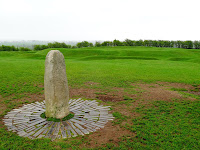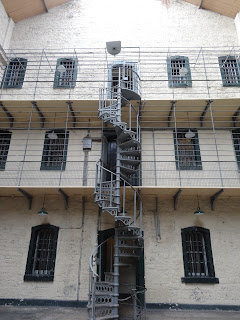Instead, the themes I explore (history, politics, culture) in my photographs over the next few posts are more like distillations, a focused way to share my experiences in Ireland - and to share something of my interests. And yes, Northern Ireland and the Republic of Ireland - the whole of the Emerald Isle - it is all one here, for my purpose.
29 April 2013 -
The overwhelming sense of History here is rich and deep. Everywhere it is linked directly with the present, and manifestations of this bond abound. So steeped is the landscape and the culture in overlapping layers of long history, recent memory, and the vivid present, that I'm still reeling from the experience.
Following each thread of history, culture, politics, and economics weaving across any place one finds oneself in - which is nothing to say of the personal and family level context of these things, gleaned from the incredibly warm interactions with the Irish I was blessed to meet - is a nigh impossible task. It was only by accepting the Whole of a place, while constantly overcome with awe, that, as I wound my way across these few short stretches of Ireland, I was able to calm myself, slow down, and enjoy - and take a few photos!
We'll start with these, with this example of early Irish history connected to the present - here, represented in a modern style as street art. Near downtown Belfast, N. Ireland.
(check artists' website, BTW - graphic artist)
Older than Stonehenge and the Great Pyramids of Egypt - Newgrange - part of the Bru Na Boine Archaeological Complex.
Here in County Meath sits this incredible structure near a bend in Boyne River, 250,000 tons of earth and stone - impenetrable to water and light except for the Winter Solstice sun for 4 days out of the year - and constructed entirely in the Stone Age.
Here, detail of the stone work (both above and below the portal) of the main entrance at Newgrange. I had NO idea this structure even existed, and truly, it is a Wonder of the Ancient world.
Nearby stone structure, located just behind and to the side of the principal Mound at Newgrange. Just amazing..

Clearly a centerpiece of the Hill of Tara complex, Lia Fail - the Stone of Destiny! - is a relic of an ancient age when features on the land and their relationships to the people and nature were imbued with divinity and held in reverence.

Once the seat and inauguration site of the Celtic High-King, the mound and landscape
around Lia Fail on the Hill of Tara retains an aura of power and
significance, even today. No moreso did that seem to be felt than during the wet,
dreary, rainy day that I was there - a day when the weather itself seemed
to obscure the Present to half-reveal the Past...
...Particularly here, at these clearly oft-visited trees. Situated at the Western edge of the whole Hill, this pair sits atop the crest of one of the outer ring walls of the Hill and bears direct, contemporary evidence of the sites' link to its Pagan and Celtic spiritual roots. I literally stumbled onto these trees while following my camera viewfinder out around the Hill; from one moment to the next, I turned around from my view of the landscape and nearly swiped my head on a branch. Of course.. I left my own spell here, too.
I was lucky enough to catch a glimpse of this Irish Round Tower - Tower Donaghmore, in County Meath - and snap some photos, while en route to Newgrange. This one is attributed to St. Patrick (or his School), who actively ministered in this region in the late 4th Century, but other sources say these towers didn't make their appearance until the 9th Century.

A real Norman castle! View of Carrickfergus Bay from the ramparts of its namesake Castle. Crrickfergus Castle, County Antrim.
Very cool building and history behind this place. A strong, proud people, the Celtic civilization has weathered many calamities and suffering; most recently, the troubles of poverty emerging out of the tumult of transitioning economies. This - the Sick and Indigent Roomkeepers Society - is oldest charity in Dublin, and was born from the grueling conditions of early industrializing Ireland.
Early political drawing - a long and bitter struggle, with conflagrations continuing into today. Though for the typical visitor and the majority of hard-working Irish families it's a much subdued struggle - the struggle continues.
Politics and struggle in Ireland intersect here - Kilmainham Gaol - in Dublin.
An early 'reform' prison when first built, it quickly became a place
for incarceration of political dissidents, activists, and organizers.
It served as the same for both the British and the Irish Free State, and
only recently reclaimed by the people as sad but important national
historic site.
A somber spot in the an already morose place - traditional site of the gallows. Also a favourite shot; with the mixed shade it was already tough to capture the blue in the sky on this hazy Dublin day. Kilmainham Gaol, Dublin.
Carndonagh Hotel. One of the cells in Kilmainham, Dublin.
Austere and graceful, there is quite a utilitarian approach to the design of some areas of the place...
..Though
not every part of the jail (gaol) is so. At least there are
windows and some natural light. These elements were features of the
prison 'reform' approach to corrections in the early 19th century. Kilmainham Gaol, Dublin.
Despite what some of the more visible social norms and mores may intimate today, the strong and nurturing image of the Woman has been - and remains! - a keystone to the vitality and pride of all the Celtic peoples. Respectively, statue near St. Stephens Green (left) and Kilmainham Gaol Museum (right). Dublin, Ireland.
Another part of history - the cathedrals and churches. Here the front facade and spire of St. Annes Cathedral, Belfast, and the the altar and rear nave of St. Peters Church, in Lurgan, County Armagh.
Here, the different stages of natural fibers in procession towards fine yarn. At Titanic Museum, Belfast.
The rapid pace and short period of (relatively, as I'm reminded when I'm in Europe) recent change - from one long and slow-developing era carried out in Ireland's rural economies, to a rapidly industrializing one in the urban areas - has helped frame the social, economic, and political context for the forms of the political struggles in Ireland.
The rapid pace and short period of (relatively, as I'm reminded when I'm in Europe) recent change - from one long and slow-developing era carried out in Ireland's rural economies, to a rapidly industrializing one in the urban areas - has helped frame the social, economic, and political context for the forms of the political struggles in Ireland.
History and art - inseparable everywhere. It's like the connection families here have to their own history and roots is a major part of their identity, and it contributes to the character of the people and nation as a whole. Serious culture. Stained glass and painting, City Hall, Belfast.
Belfast skyline, seen from the waterfront locks - the very structures that have allowed the bay and harbour to have so burgeoned for over 150 years.
Red fields of County Omagh, approaching Gortin Glen Forest Park. Thanks to some very talented, very cool new friends who invited me to this awesome part of the Isle.
Here, too, friends brought me, and showed me to another side of Ireland - the inside, from Kilwilke Road, Lurgan, County Armagh. Brief but incredibly warm and inviting glimpses into local life. Go raibh maith agaibh.
The photos laid out heretofore are taken with a Sony Cybershot DSC-HX30V
These works by Tim Paez are licensed under a Creative Commons Attribution-ShareAlike 3.0 Unported License

































